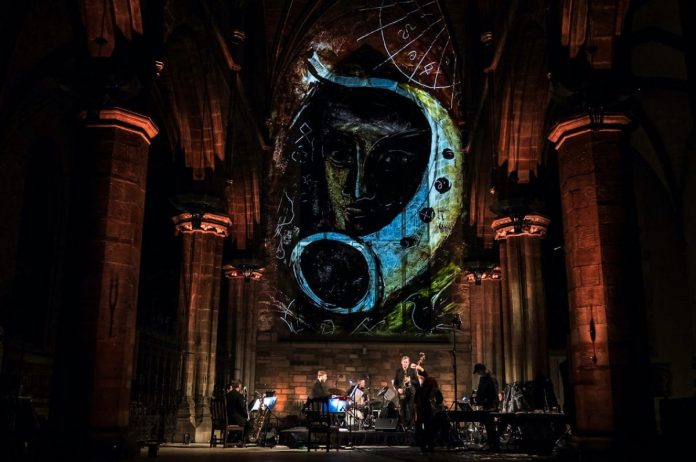
In the sleeve-note for his Coming Yesterday, Martial Solal’s recent valedictory concert recording from Salle Gaveau in Paris, the surpassing pianist remarks that “Great freedom requires a lot of work.” I imagine Solal’s words would strike a special chord with each and every participant who contributed to the Herculean achievement that was Where Rivers Meet.
Celebrating the spirit of 1960s and 1970s free jazz in America, this boldly conceived and richly realised series of concerts by The Scottish National Jazz Orchestra – presented in livestream format over four nights (12-15 May 2021) from Edinburgh’s magnificent St Giles Cathedral (or High Kirk) – must rate as one of this outstanding ensemble’s most memorable achievements to date.
Where Rivers Meet sought to reignite and recast the often blues-fired or gospel-fed freedom of melodic expression to be found in the diversely wrought but equally potent music of black Americans Ornette Coleman, Dewey Redman, Anthony Braxton and Albert Ayler. The result was a resonant and deeply affirmative experience, which made it especially difficult to comprehend the hostility and outright rejection initially experienced by many free-jazz practitioners, particularly Coleman and Ayler.
Each concert focused on the music of one musician, with three representative pieces chosen by the assigned SNJO soloist of the night. Each of these soloists – Paul Towndrow (as), Konrad Wiszniewski (ts), Martin Kershaw (as) and SNJO founder and director, Tommy Smith (ts) – played with compelling authority, responding brilliantly to the sequence of dynamically and chromatically wide-ranging arrangements supplied by Smith (for the Coleman material, including Lonely Woman and Peace, played by Towndrow), Towndrow (for the Redman numbers, including Dewey’s Tune and Joie De Vivre, interpreted by Wiszniewski), Paul Harrison (for the Braxton items, played by Kershaw and which featured perhaps the most extraordinary arrangement of all the concerts in the diversely layered and developed No. 245), and Geoffrey Keezer (for the concluding Ayler concert, with Smith playing Ghosts, Dvořák’s Goin’ Home and the classic When The Saints Go Marchin’ In).
The work of the Russian, Edinburgh-domiciled painter and multi-media artist Maria Rud contributed a further essential dimension to the proceedings. Projected digitally onto the West Window of St Giles, her fluid improvisations offered continuous complement, as soulful as it was vivid, to both the visceral immediacy and unfolding structural intelligence of the music.
Rud is well known for her chromatically rich imagery, with its transfigured overtones of Picasso and Chagall as well as early Russian icon painting. Her previous Animotion Show performances with musicians of the calibre of Evelyn Glennie had revealed her consummate mastery of liquid paint on transparent surface, the digitally projected images, sigils and signs seeming to emerge in a trance-like manner, at times recalling the activities of the shamans of old. Where Rivers Meet was the first time that Rud had worked with jazz musicians – and clearly, she loved the experience.
“For me”, Rud explained, “ jazz has the energy of rock and the complexity of classical music.” Watching her smiling and dancing moves and grooves – paint brush, sponge and bare hands ever at work – to pieces like Coleman’s Broadway Blues, Redman’s Joie De Vivre and Smith’s inspirational take on The Saints, it was obvious that Rud felt the play of swing and jazz dynamics to her bones. Integrating full-on colour with black and white, figuration and abstraction, geometric and organic tropes, the manner in which Rud had the courage first to create and then erase potent passages of archetypal import, delving then deeper into her dream-like quest, offered an uncanny parallel to the many shape-shifting delights of the music.
Each streamed concert was presented in both HD and regular YouTube formats. And each of the four concerts was preceded by an informative and insightful spoken introduction from both Tommy Smith and the featured soloist of the evening. As Smith said, if pandemic restrictions had meant that the SNJO could not follow its regular policy of inviting major musicians from abroad to participate, that also meant that the quality of the SNJO’s own estimable improvisers and arrangers could be highlighted to due degree. And such was indeed the case.
Lead trombonist Kieran McLeod took a riveting, cogently variegated solo on No. 245, the concluding number of the Braxton concert, underlining the breadth and depth of quality in an orchestra driven with both overall verve and the most astute attention to detail by the spot-on Pete Johnstone (p), Calum Gourlay (b) and Alyn Cosker (d). Cosker shone especially on the concluding Saints, building the sort of irresistible rocking Second Line groove that might indeed raise the dead.
Now there you have my jazz, as Maya Angelou might have said. Fabulous stuff, these concerts, from first note and painted mark to last. Bravo!















